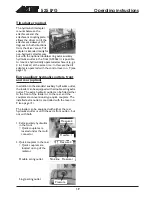
525 LPG
Safety instructions
5
Handling of heavy loads and load sensor
The loader is equipped with a load sensor system. It
gives an audible warning signal and at the same time
an indicator lights in the dashboard when there is a risk
that the machine tips over its front axle. When the
system gives a warning signal the load that is being lifted
is too heavy in relation with the lift capacity of the
loader. In this case one has to either put more counterweights
on the loader or relieve the load that is being lifted.
When the load sensor starts to warn, there is
a risk that the machine tips over its front axle.
In this case stop lifting of the boom, retract
the telescopic boom and lower down the boom
slowly. When the load sensor is warning do
not steer the machine before the boom is
lowered down close to ground level. Lift the
boom only when the loader chassis is straight.
Keep the load as close to ground as possible.
Never take a heavy load on the loader from
high level e.g. from truck, shelf etc. risk
of tipping over!
Always put the load down on the ground before
leaving the machine. When loading, always
keep the loader chassis as straight as possible.
Personal safety and protective equipment
Wear safe clothing and personal protective equipment
(PPE). Protect yourself against work hazards like noise,
ejecting debris or dust for example.
Noise level at drivers seat can exceed
85 dB(A). Wear hearing protection
when working with the loader.
It is recommended to wear safety
footwear when working with the loader.
Wear protective gloves when handling
hydraulic hoses.
Follow regulations regarding
protective equipment. Wear eye
protection and hard hat or other
protective equipment as needed.
Read Operators Manual of the attachment for more information
about protective equipment needed in the work.
Safety frame (ROPS) and safety canopy (FOPS)
Safety frame (ROPS) protects the operator
in case the machine tips over. Always fasten
the seat belt in order to stay inside the safety
frame protective area. Never take off the
safety frame.
When working in conditions where falling objects may
be a risk (on building sites etc.), the loader must be
equipped with a falling objects protective canopy
(FOPS), part no. A48906.
Electric system
Lead acid batteries can produce flammable and
explosive gases. Make sure that the ventilation is
sufficient and keep arcs, sparks, flames and lighted
tobacco away from battery.
Battery acid causes severe burns. In case of acid
contact, wash immediately with water for several
minutes and get medical attention in case of eye
contact.
Read the instructions for jump start on page 30.
Never charge a frozen battery.
AVANT 525LPG safety
Make sure that ventilation is sufficient in the
working area, also when working with the
loader with an LPG engine. The emissions of
a vehicle with LPG (Liquefied Petroleum Gas)
engine are cleaner than those of a diesel
engine, but using the loader in poorly
ventilated areas can lead to dangerously high
levels of carbon monoxide (CO) and dioxide
(CO2) in the air.
Liquefied Petroleum Gas is extremely flammable
and can, when it mixes with air, create an
explosive mixture which ignites very easily.
Handle the LPG equipment with care and
stop the use immediately if you think that
it may be damaged. Contact authorized
service to sort out the problem.
Remember that LPG is heavier than air. Make sure
to ventilate well.
Always close the gas bottle valve when the loader
is not in operation.
Stop the engine and switch off main current with
the battery disconnect switch when changing the
gas bottle.
Service the LPG system regularly and replace
damaged an worn out components immediately.
Do not make changes to the LPG system. Contact
authorized service if necessary.
Remember that the gas vaporizer can cool down
to a very low temperature during operation, which
may cause that moisture in the air condensates on
the vaporizer. It is not allowed to heat the vaporizer
with any external heater.
In case of gas leak
Stop the engine and switch off main current immediately.
Close the gas bottle valve and let the engine cool
down completely. Ventilate well.
Find out the location of the gas leak by wetting down
the parts with soap-water solution. Replace faulty
components. Contact authorized Avant service if
necessary.



























